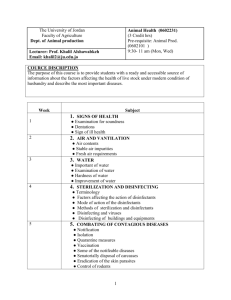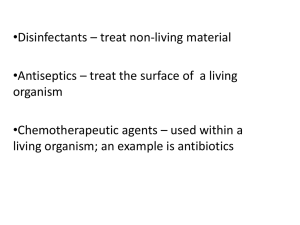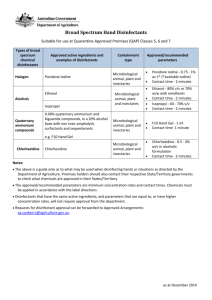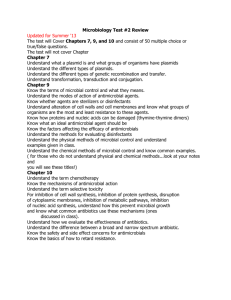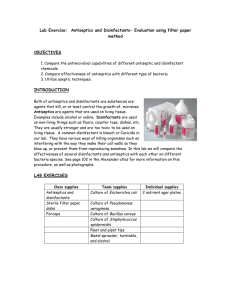Document 14104703
advertisement
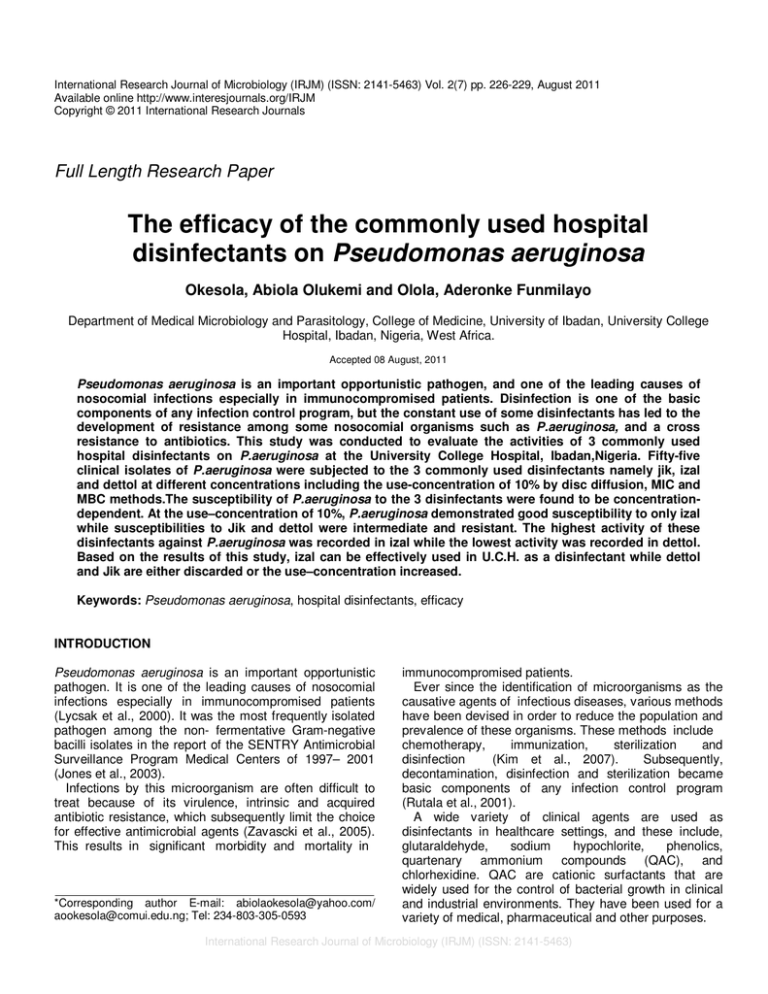
International Research Journal of Microbiology (IRJM) (ISSN: 2141-5463) Vol. 2(7) pp. 226-229, August 2011 Available online http://www.interesjournals.org/IRJM Copyright © 2011 International Research Journals Full Length Research Paper The efficacy of the commonly used hospital disinfectants on Pseudomonas aeruginosa Okesola, Abiola Olukemi and Olola, Aderonke Funmilayo Department of Medical Microbiology and Parasitology, College of Medicine, University of Ibadan, University College Hospital, Ibadan, Nigeria, West Africa. Accepted 08 August, 2011 Pseudomonas aeruginosa is an important opportunistic pathogen, and one of the leading causes of nosocomial infections especially in immunocompromised patients. Disinfection is one of the basic components of any infection control program, but the constant use of some disinfectants has led to the development of resistance among some nosocomial organisms such as P.aeruginosa, and a cross resistance to antibiotics. This study was conducted to evaluate the activities of 3 commonly used hospital disinfectants on P.aeruginosa at the University College Hospital, Ibadan,Nigeria. Fifty-five clinical isolates of P.aeruginosa were subjected to the 3 commonly used disinfectants namely jik, izal and dettol at different concentrations including the use-concentration of 10% by disc diffusion, MIC and MBC methods.The susceptibility of P.aeruginosa to the 3 disinfectants were found to be concentrationdependent. At the use–concentration of 10%, P.aeruginosa demonstrated good susceptibility to only izal while susceptibilities to Jik and dettol were intermediate and resistant. The highest activity of these disinfectants against P.aeruginosa was recorded in izal while the lowest activity was recorded in dettol. Based on the results of this study, izal can be effectively used in U.C.H. as a disinfectant while dettol and Jik are either discarded or the use–concentration increased. Keywords: Pseudomonas aeruginosa, hospital disinfectants, efficacy INTRODUCTION Pseudomonas aeruginosa is an important opportunistic pathogen. It is one of the leading causes of nosocomial infections especially in immunocompromised patients (Lycsak et al., 2000). It was the most frequently isolated pathogen among the non- fermentative Gram-negative bacilli isolates in the report of the SENTRY Antimicrobial Surveillance Program Medical Centers of 1997– 2001 (Jones et al., 2003). Infections by this microorganism are often difficult to treat because of its virulence, intrinsic and acquired antibiotic resistance, which subsequently limit the choice for effective antimicrobial agents (Zavascki et al., 2005). This results in significant morbidity and mortality in *Corresponding author E-mail: abiolaokesola@yahoo.com/ aookesola@comui.edu.ng; Tel: 234-803-305-0593 immunocompromised patients. Ever since the identification of microorganisms as the causative agents of infectious diseases, various methods have been devised in order to reduce the population and prevalence of these organisms. These methods include chemotherapy, immunization, sterilization and disinfection (Kim et al., 2007). Subsequently, decontamination, disinfection and sterilization became basic components of any infection control program (Rutala et al., 2001). A wide variety of clinical agents are used as disinfectants in healthcare settings, and these include, glutaraldehyde, sodium hypochlorite, phenolics, quartenary ammonium compounds (QAC), and chlorhexidine. QAC are cationic surfactants that are widely used for the control of bacterial growth in clinical and industrial environments. They have been used for a variety of medical, pharmaceutical and other purposes. International Research Journal of Microbiology (IRJM) (ISSN: 2141-5463) Okesola and Olola 227 They are generally low–level disinfectants showing activity against Gram–positive and Gram–negative bacteria (MacBain et al., 2004). However, P.aeruginosa has been reported to particularly demonstrate resistance to biocides (Higgins et al., 2001). The antimicrobial activity of disinfectants have been influenced by their formulation effects, level of organic load, synergy, temperature, dilution rate and tests methods (Russel et al., 1995). Gram–negative bacilli have been tested for susceptibility to disinfectants with various disagreeing results (Rutala et al., 1997; Saurina et al., 1997). The widespread use of antiseptic and disinfectant products has also prompted some specialists to speculate on the development of microbial resistance to them and the subsequent cross-resistance to antibiotics (McDonnel et al.,1999). Therefore, the selection, use, and control of the effectiveness of the disinfectants have been emphasized, since environmental surfaces, medical and surgical instruments can serve as vehicles to infectious agents in susceptible hosts associated with the hospital setting (Rutala, 1997). In view of the importance of disinfection in the prevention of nosocomial infections, and some reports which claimed that antimicrobial activity of disinfectants are concentration–dependent, the aim of this study is to evaluate the activities of the various concentrations of the frequently used disinfectants at University College Hospital, Ibadan, Nigeria. The study will also verify whether the use-concentration of 10% employed by the hospital is effective. Disinfection susceptibility test The susceptibility of P.aeruginosa to these disinfectants was determined by the disc diffusion test as described by WHO in 2003 (WHO, 2003),minimum inhibitory concentration (MIC) and minimum bactericidal concentration (MBC) methods as described by Turnidge et al in 2003. Serial dilutions of each of the disinfectants were made at 100%, 50%, 25%, 12.5%, 6.25% and 3.125%. The use–concentration of 10% of each of the disinfectants was also included in the evaluation tests. The susceptibility of P.aeruginosa strains to the various concentrations of these disinfectants were then determined by the above-mentioned methods (i.e. the disc diffusion tests, MIC and MBC). For the disc diffusion method, the diameters of the zones of inhibition were measured by a meter rule and the values obtained were compared with those of the interpretive chart for standardization (Johnson et al., 1995). In the interpretive chart, the diameters of zones of inhibition in the susceptible strains were 16mm or more, for intermediate resistance, the diameters were between 11mm and 15mm and for the resistant strains, the diameters of zones of inhibition were 10mm or less (Johnson et al., 1995). The diameters of zones of inhibition obtained from the test organisms, when compared with those in the interpretive chart, were interpreted as susceptible, intermediate resistance and resistant. MATERIALS AND METHODS RESULTS Bacterial isolates Fifty–five clinical isolates of P.aeruginosa obtained from various clinical specimens brought to the diagnostic medical microbiology laboratory of University College Hospital, Ibadan, Nigeria, between April and July 2009, were included in this study. Disinfectants The commonly used commercial disinfectants at University College Hospital were obtained from the same source as the hospital. These disinfectants were Jik (sodium hypochlorite), Izal(phenolic compound), and dettol (chloroxylenol). The use–concentration of these disinfectants in this hospital was 10%. In this study, the susceptibility of P.aeruginosa to the disinfectants were found to be concentration–dependent. The susceptibility pattern of P.aeruginosa to the various disinfectants at different concentrations of 100%, 50%, 25%, 12.5%, 10%, 6.25% and 3.125% are shown in tables 2 and 3. At the use–concentration of 10% in the study hospital, P.aeruginosa demonstrated good susceptibility to only izal with diameters of zones of inhibition range between 12mm and 17mm with majority in the range between 16mm and 17mm. For jik, the susceptibility was intermediate, while for dettol, P.aeruginosa demonstrated mainly intermediate resistance and in some of the strains, resistance. The highest MIC and MBC (i.e. the lowest activity) of these disinfectants against P.aeruginosa was recorded International Research Journal of Microbiology (IRJM) (ISSN: 2141-5463) 228 Int. Res. J. Microbiol. Table 1: Frequency of isolation of P.aeruginosa from different clinical specimens. Clinical Specimens Wound Swabs Ear Swabs Urine Stool Sputum Pus Catheter tips Total Frequency 22 22 2 1 3 1 4 55 Percentage (%) 40.0 40.0 3.6 1.8 5.5 1.8 7.3 100.0 Table 2: Activities of disinfectants on P.aeruginosa at various concentrations. Diameters of zones of inhibition (mm)/Interpretation Concentrations disinfectants (%) of Interpretation 100 JIK (mm) 16-18 1ZAL (mm) 19-23 Interpretation Susceptible DETTOL (mm) 14-16 16-21 Susceptible 14-15 12-14 Intermed resist/ susceptible Intermed resist Intermed resist /susceptible Intermed resist 50 14-16 25 15-20 11 -14 Intermed resist 12.5 *10.0 12-14 11-13 Intermed resist Intermed resist 13– 19 12 -17 11 – 14 10 – 13 6.25 11-12 Intermed resist 12 -17 Intermed resist / susceptible Intermed resist Intermed resist/ susceptible Intermed resist / Susceptible 3.125 7-10 Resistant 11 -14 Intermed resist Resistant / Intermed resist Resistant/ Intermed Resist Resistant Susceptible 9 -11 Intermed resist 6-10 Interpretation *Use-concentration of disinfectants in study hospital (U.C.H). Table 3: MIC and MBC range of disinfectants against P.aeruginosa Disinfectant JIK Izal Dettol MIC range (ug/ml) 0.07 – 0.10 0.03 – 0.06 0.13 for dettol while the lowest MIC and MBC (i.e. the highest activity) was recorded for izal (Table 3). DISCUSSION This study has further confirmed that the antimicrobial activities of 3 commonly used disinfectants at University College Hospital, Ibadan, Nigeria, against clinical isolates of P.aeruginosa are concentration-dependent. This is in keeping with the work done by Awodele et al, in 2007. The use–concentration of 10% of the disinfectants in this MBC range (ug/ml) 0.10 – 0.13 0.06 – 0.10 0.25 hospital showed good susceptibility to only izal with diameters of zones of inhibition that range between 16mm and 17mm. Susceptibility to the other disinfectants, i.e. Jik and dettol, were however, found to be either intermediate resistance or resistant (Table 2). Pseudomonas aeruginosa is a known contaminant of skin, laboratory surfaces, toilets and pools. It is also known to be one of the organisms implicated in nosocomial infection outbreak especially in intensive care units (Jones et al., 2003). Furthermore, its susceptibility is known to be limited to only a few antimicrobial agents. Some disinfectants are reported to share the same International Research Journal of Microbiology (IRJM) (ISSN: 2141-5463) Okesola and Olola 229 mechanism of action with some antibiotics and this can cause resistance to disinfectants used in cleaning our environments. Therefore, based on this fact, it is obvious that resistance to disinfectants especially in the hospital setting could be antibiotic–resistance related as a result of cross–resistance (Heath et al., 2001).Some other studies have also suggested a potential molecular link between reduced susceptibility to some disinfectants and antibiotic resistance. Increased resistance to antiseptics and disinfectants have been associated with mutation, and, or presence of plasmids (Kaulfers et al., 1987), and both have been observed in some strains of P.aeruginosa (Sulton et al., 1978). Most antimicrobial agents show both inhibitory and lethal effects depending on the concentration used and other factors such as degree of contamination and duration of treatment. The MIC is a helpful parameter used to assess the bacteriostatic activity of a given disinfectant while the MBC is used to detect bactericidal activity under similar conditions. The MIC and MBC values of dettol, jik and izal obtained in this study showed that concentration of the active ingredients in the recommended dilutions of the disinfectants is lethal to the organism. CONCLUSION In conclusion, the reduced activity of the disinfectants under study may be due to indiscriminate use of these disinfectants in sub-optimal concentrations over a long period of time. The use of sub-optimal concentrations might lead to the development of resistant and virulent strains of organisms. The use of concentrations of disinfectants lower than that quoted by the manufacturers might have serious consequences in the management of patients in hospitals. This study therefore emphasizes the need for hospitals to adhere strictly to standard disinfection policy which gives a guide for proper use of disinfectants and antiseptics. In this study, only izal is effective against P.aeruginosa among the disinfectants used in U.C.H at the useconcentration of 10%. The others, dettol and jik employed, have intermediate activity to P.aeruginosa, and therefore, may have to be either discarded and replaced by more effective disinfectants or used at higher concentrations. REFERENCES Awodele O, Emeka PM, Agbamuche HC, Akintonwa A (2007). The antimicrobial activities of some commonly used disinfectants on Bacillus subtilis, Pseudomonas aeruginosa and Candida albicans. Afr J Biotech 6(8): 887-990. Heath RJ, White SW, Rock CO (2001). Lipid biosynthesis as a target for antibacterial agents. Prog. Lipid. Res. 40: 467-497. Higgins CS, Murtough SM, Hiom SJ, Payne DJ, Russel AD, Walsh TR (2001). Resistance to antibiotics and biocides among nonfermenting Gram- negative bacteria. Clin. Microbiol. Infect. Dis. 7: 308-315. Johnson T, Case C (1995). Chemical methods of control adapted from th Laboratory Experiments in Microbiology . Brief Edition, 4 ed. Jones NJ, Sader HS, Beach ML (2003). Contemporary in vitro spectrum of activity summary for antimicrobial agents tested against 18569 strains of non-fermentative Gram-negative bacilli isolated in the SENTRY Antimicrobial Surveillance Program (1997-2001). Int. J. Antimicrob Agents. 22:551-556. Kaulfers PM, Karch H, Laufs R (1987). Plasmid-mediated formaldehyde resistance in Serratiamarcescens and Escherichia coli: Alterations in the cell surface. Zentbl. Bakteriol. Parasitol. Infektion. Skr. Hyi. I Abt. Orig. Reihe. 226:239-248. Kim YM, Farrah S and Baney RH (2007). Structure-antimicrobial activity relationship for silanols, a new class of disinfectants, compared with alcohols and phenols. Int. J. Antimicrob. Ag. 29: 217-222. Lycsak JB, Cannon CL, Pier GB (2000). Establishment of Pseudomonas aeruginosa infection: lessons from a versatile opportunist. Microb. Infect. Pp 1051-1060. MacBain AJ, Ledder RG, Moore LE, Catrenich CA, Gilbert P (2004). Effects of quartenary-ammonium-based formulation on bacterial community dynamics and antimicrobial susceptibility. Appl. Environ. Microbiol. 70: 3449-3456. McDonnel G, Russel D (1999). Antiseptics and disinfectants: activity, action, and resistance. Clin. Microbiol. Rev.12: 147-149. Russel AD, Russel NJ (1995). Biocides: activity, action and resistance. Symp Soc Gen Microbiol 53: 327-365. Rutala WA (1997). Disinfection, Sterilization and waste disposal. In Wenzel, RP (ed). Prevention and control of nosocomial infections. Williams and Wilkins, Baltimore pp 539-593. Rutala WA, Siegel MM, Sambbi EA, Weber DJ (1997). Susceptibility of antibiotic–susceptible and antibiotic-resistant hospital bacteria to disinfectants. Infect. Control. Hosp. Epidemiol. 18: 417-421. Rutala WA, Weber DJ (2001). Surface disinfection: should we do it?. J. Hosp. Infect. 48: 864-868. Saurina G, Landman D, Duale JM (1997). Activity of disinfectants against vancomycin-resistant Enterococcus faecium. Infect. Control. Hosp. Epidemiol. 18: 345-347. Sulton L, Jacoby GA (1978).Plasmid-determined resistance to hexachlorophene in Pseud.aeruginosa. Antimicrob. Ag. Chemother. 13: 634-636. Turnidge JD, Ferraro MJ, Jorgen JH (2003). Susceptibility test methods: General considerations. Manual of Clinical. Microbiol. 8:219-223. World Health Organization (WHO) (2003). Manual for the laboratory identification and antimicrobial susceptibility testing of bacterial pathogens of public health importance in the developing world. Boyce and Pillet. Zavascki AP, Cruz RP, Goldani LZ (2005). Risk factors for imipenemresistant Pseudomonas aeruginosa; a comparative analysis of two case-control studies in hospitalized patients. J. Hosp. Infect. 59: 96101. ACKNOWLEDGEMENT The authors appreciate the secretarial assistance of Mr Abiodun Oladijo. International Research Journal of Microbiology (IRJM) (ISSN: 2141-5463)
